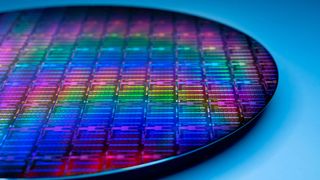Stacked 3D cache is coming to Intel CPUs, and gamers should be excited
Not imminently though.

Intel's Innovation 2023 event is underway in San Jose. The headline is the launch of the exciting Meteor Lake architecture. As a laptop oriented architecture, Meteor Lake chips aren't necessarily going to be the ultimate gaming CPUs, but next gen chips may well be, as Intel's CEO revealed the company is developing chips with 3D stacked cache—which is something games in particular can take advantage of.
Our sister site Tom's Hardware was present during a Q&A session held by Intel CEO Pat Gelsinger. He was asked whether Intel would adopt stacked cache designs, and the answer was yes!
Gelsinger is quoted as saying "When you reference V-Cache, you're talking about a very specific technology that TSMC does with some of its customers as well. Obviously, we're doing that differently in our composition, right? And that particular type of technology isn't something that's part of Meteor Lake, but in our roadmap, you're seeing the idea of 3D silicon where we'll have cache on one die, and we'll have CPU compute on the stacked die on top of it, and obviously using EMIB that Foveros we'll be able to compose different capabilities."
That's great news for gamers. AMD's X3D chips have proven themselves to be excellent gaming CPUs, and it's all down to huge amounts of level 3 cache.

Best CPU for gaming: The top chips from Intel and AMD.
Best gaming motherboard: The right boards.
Best graphics card: Your perfect pixel-pusher awaits.
Best SSD for gaming: Get into the game ahead of the rest.
Games tend to prefer low latency, close-to-the-cores cache. With more on-package cache, the CPU doesn't have to access the relatively slow system memory as often, helping to boost performance.
Intel's Raptor Lake CPUs are hardly slouches when it comes to gaming, and future desktop chips like Lunar Lake are sure to be even better. One wonders what effect large caches will have on Intel's gaming performance, and how it compares to AMD's future Zen 5 or Zen 6 families, which are sure to include V-cache models too.
As Pat Gelsinger said, 3D cache is not a part of Meteor Lake, but it is on the roadmap. Intel is proud of its Foveros technology and advanced packaging methods, and I for one am very excited to see where Intel goes with its stacked cache approach in the years ahead.
Comic deals, prizes and latest news
Sign up to get the best content of the week, and great gaming deals, as picked by the editors.
Bring it on!

Chris' gaming experiences go back to the mid-nineties when he conned his parents into buying an 'educational PC' that was conveniently overpowered to play Doom and Tie Fighter. He developed a love of extreme overclocking that destroyed his savings despite the cheaper hardware on offer via his job at a PC store. To afford more LN2 he began moonlighting as a reviewer for VR-Zone before jumping the fence to work for MSI Australia. Since then, he's gone back to journalism, enthusiastically reviewing the latest and greatest components for PC & Tech Authority, PC Powerplay and currently Australian Personal Computer magazine and PC Gamer. Chris still puts far too many hours into Borderlands 3, always striving to become a more efficient killer.
Most Popular





